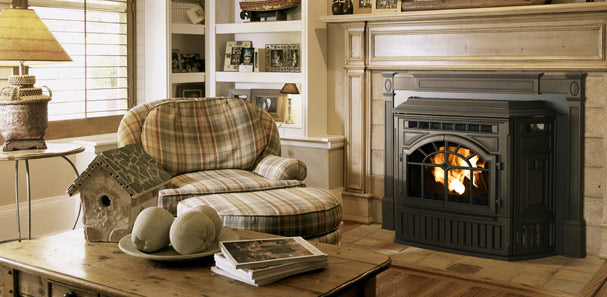Maintenance tips for homeowners with hearth products

Spring breezes are here and summer is right around the corner. We asked our experts to provide guidance about preparing stoves and fireplaces for the off-season, and here’s what they said.
Wood Fireplaces and Inserts
- Clean the firebox. Vacuum up ashes now so you’re ready for fires this fall! To protect your lungs and hands, wear a dust mask and gloves. Also, remove any creosote or soot buildup on the walls and lower parts of the chimney. You can use a use a pair of safety glasses, a good flashlight and a mirror to look up the flue.
- Annual chimney cleaning. Use the summer months to locate a reputable chimney sweep for the fall. Every year, thousands of home fires start in the chimney due to improper maintenance. Many of them are caused by creosote – a flammable tarlike substance that’s a byproduct of burning wood. Chimneys should be inspected and “swept” or cleaned at least once a year. We recommend hiring someone certified by the Chimney Safety Institute of America.
Wood Stoves
- Inspect your stove. Give your stove a close look now, so it’s fire-ready when the cold weather moves in this fall.
- Look at the door gaskets. The seal should be so tight that a piece of paper or a dollar bill inserted between the door and the stove can’t be pulled out when the door is closed. Replace the gaskets if needed. A tight door seal will help to create good draft and prevent smoke leakage. Watch a video here.
- Ensure the stove pipe is in good condition, especially where it connects to the chimney. Stove pipes are subjected to high temperatures and if corrosion develops, the pipe should be replaced.
- Check the inside of your stove for cracks in the brick or damaged baffles. If anything needs attention, call your stove dealer, or if you order parts yourself, consult your owner’s manual.
- Annual chimney cleaning. Use the summer months to locate a good chimney sweep in your area for the fall. They will look for cracks, leaks, warping, baffle gaps, creosote buildup or other obstructions that could potentially lead to chimney fires or carbon monoxide intrusions. Find someone who’s certified by the Chimney Safety Institute of America.
Pellet Stoves and Inserts
- Annual Maintenance. Be ready for fires this fall! Remove ash from the burn chamber and the ash pan, scraping the burn pot, and removing ash from vital components. Wear heat resistant gloves to protect your hands and arms, and deposit ashes in a metal container with a lid that is stored far away from any combustible materials. Consult your owner’s manual for specific instructions.
- Clean the glass. Do this when the stove is completely cool. Use a soft cloth and a glass cleaner specially formulated for wood or pellet stove glass. Don’t scrape the glass with sharp objects – scratches will compromise the integrity and strength of the glass.
- Choose the right stove. Some brands of pellet stoves require less maintenance than others. Good examples are those manufactured by Quadra-Fire. Our pellet stoves are outfitted with today’s best technologies for making heating with pellets as easy as possible for you.
Gas Fireplaces and Inserts
- No ash. Because they burn natural gas or liquid propane, there is no ash to clean up.
- Clean the glass. Make sure the gas valve is off and the glass is completely cool. Remove the front face the fireplace, carefully remove the glass assembly (follow instructions in owners’ manual), and lay it on a soft surface. Wipe down both sides of the glass with a soft cloth and a cleaner specified for fireplaces, like Stove Bright or Rutland White Off glass cleaners. When finished, put the glass back on the fireplace. Never use abrasive cleaners or cloths. Scratching can cause the glass to shatter.
- Clean the inside of the fireplace or insert. When the front glass is off (see above), remove any dirt or dust using a soft paint brush or vacuum.
- Inspect. Check the inside of your gas fireplace for any damage, such as rust or flaking. Call a dealer if you need replacement parts.
By performing these simple maintenance steps now, you’ll be ready for fires this fall! Meanwhile, enjoy the summer.


